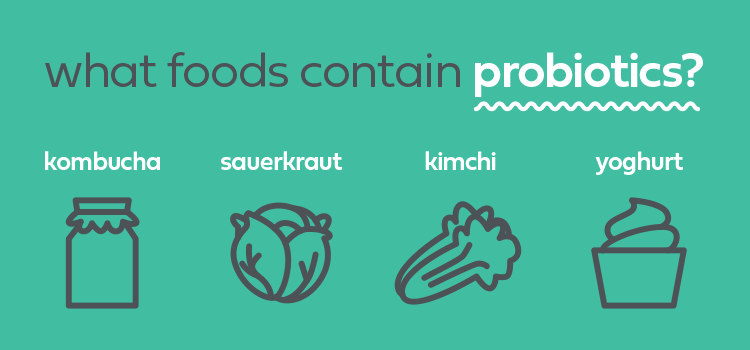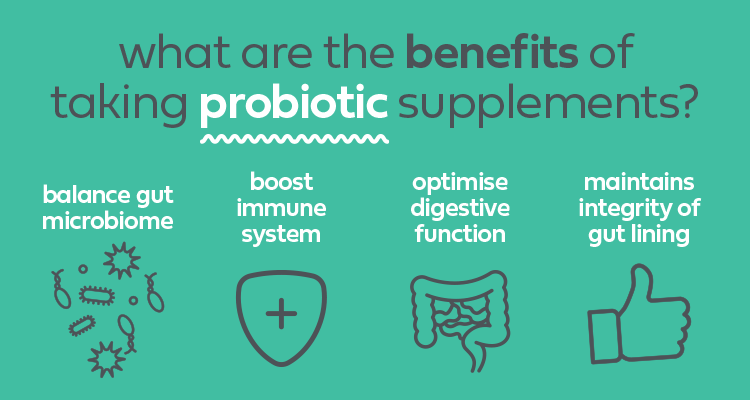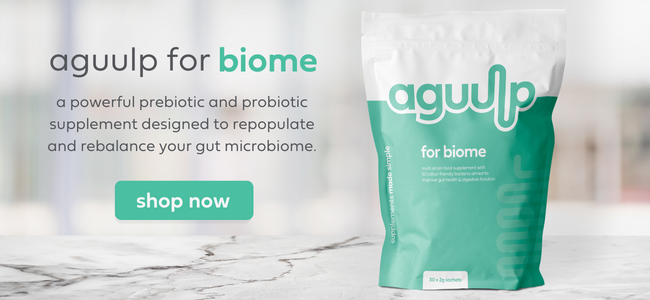Can you get enough probiotics from food?

Probiotics, we talk about it a lot at aguulp because we know how beneficial they can be not only for our gut health but our overall general health too. You’ve probably heard of foods and drinks like yoghurt, kimchi, sauerkraut and kombucha, all because they’re packed with probiotics and can (apparently) do wonders for our health. So, we thought, why not dig deeper and find out if we can get enough probiotics from food.
In this week’s Expert Series we look at the different foods that contain probiotics and how they may be beneficial for our health. Plus, we’re going to answer the question: is eating right all you need to do to enjoy the benefits of probiotics? We’ll dive into the world of probiotic supplements, giving you our top tips on finding the perfect probiotic supplement.
What are probiotics?
Probiotics are friendly live bacteria and yeasts known for their health benefits. They come in various genus, species, and strain combinations, each with unique properties. While predominantly residing in the digestive system, probiotics can also be found in the urinary and reproductive systems, as well as on the skin. These beneficial microorganisms are available in both supplement form and in a variety of fermented foods, drinks, and dairy products. For more information on probiotics, head over to our blog “can you take prebiotics and probiotics together?”
What foods contain probiotics?
Fermented foods:
These are foods that are produced or preserved by the action of microorganisms. There are two main processes and are known as Lacto-fermentation. One method is the process where sugar is converted to alcohol using yeast under anaerobic conditions. Another main method of fermentation involves the use of lactic acid-based bacteria (e.g. lactobacillus) to act on dairy products or vegetables, which aids in their preservation and increases their good probiotic content. This process not only increases the probiotic content of foods but also fosters the production of beneficial enzymes, B vitamins, omega-3 fatty acids, amino acids, sodium, fibre, and calcium.
Lacto-fermented foods have been around for a very long time. Common in Korean, Chinese, Japanese and North and Central European cuisine, fermentation has been used to enhance the flavour of food, create food, and help food have a longer shelf life. Fermented foods are highly nutritious. Fermented foods are also often high in amino acids, sodium, fibre and calcium.
Examples of fermented foods:
Kefir:
This is a fermented milk drink made with kefir ‘starter grains’ which consists of both yeasts and bacteria alongside milk proteins and complex sugars. Generally, those with lactose intolerance are able to tolerate kefir, as very low levels of lactose remain following the fermentation process of kefir. Kefir is high in amino acids (protein), vitamins and minerals and conjugated linoleic acid (CLA).
In terms of probiotic content, kefir contains several major strains of friendly bacteria and beneficial yeasts, which play a role in the control and elimination of pathogenic yeasts in the body.
Kombucha:
Kombucha is a non-alcoholic beverage and it is the result of a fermentation process using a combination of a tea infusion (tea, juices, herb extracts) with a type of yeast known as a SCOBY (symbiotic culture of bacteria and yeast). Traditionally Kombucha was prepared using sweetened green and black tea but in more recent years, as a result of promising laboratory studies, other plant species providing other types of bioactive compounds are now being used leading to variations in its composition.
According to research and studies, Kombucha is an excellent source of probiotics and antioxidants. It is also a good source of vital nutrients such as B complex vitamins, polyphenols (plant derived compounds), and organic acids, all of which are believed to offer various health benefits.
In addition to the increased probiotic content, studies show that the fermentation process of kombucha also results in the production of various active compounds that have antimicrobial, antioxidant, and anti-inflammatory potential.
Read more about kombucha on our blog ‘What is kombucha: everything you need to know’
Kimchi:
Considered to be a staple dish in Korea, Kimchi consists of salted and fermented vegetables, predominantly being Chinese cabbage and/or radishes, and various flavouring ingredients (eg. chilli, pepper, garlic, onion). The fermentation process occurs by microorganisms naturally found on the cabbage and foods included in the mixture.
Strains of Lactobacillus bacteria are found on the surface of the cabbage and convert the sugar and carbs in the cabbage into lactic acid, helping to preserve the cabbage and other vegetables such as onion, garlic and ginger in the dish, resulting in an intense flavour.
As kimchi can comprise a variety of ingredients, the microbial composition varies depending on the type and amount of the foods included.
Sauerkraut
Finely shredded cabbage that has been fermented by lactic acid bacteria. Sauerkraut provides both pre and probiotics. It is rich in fibre, sodium, iron and potassium, as well as Vitamins C and K. Sauerkraut also contains the antioxidants lutein and zeaxanthin
It is important to note that the pasteurisation process that shop bought sauerkraut typically undergoes destroys the beneficial bacteria, therefore homemade sauerkraut is a better option in terms of preserving the probiotic content.
Tempeh
Tempeh, a renowned fermented delicacy originating from Indonesia, stands out for its exceptional nutritional profile. Crafted through a meticulous fermentation process, tempeh retains the entirety of the soybean, resulting in higher vitamin and phytochemical content, essential amino acids, and a robust texture and flavour compared to tofu. The fermentation also enhances the digestibility of soy protein while preserving its dietary fibre content. Notably, tempeh is a complete protein source, providing all essential amino acids in one package.
Miso
Originating in Japan and made from fermented and aged soya beans. Soya beans are rich in calcium, phosphorus, iron, other minerals and lecithin.
Miso also contains living enzymes that aid our digestive process and provides a nutritional balance between carbohydrates, essential oils, vitamins, minerals and proteins. It actually has 11 times more protein than cow’s milk, and twice as much protein as meat or fish.
Yoghurt and yoghurt drinks:
It’s no surprise that yoghurts and yoghurt drinks are renowned for being a source of probiotic bacteria. It is a popular choice because it is more widely available compared to other foods with probiotic content. Yoghurts are also an excellent source of live cultures, protein, calcium and vitamin D.
It is made by adding bacteria to milk and leaving it to ferment until the bacteria grows and produces lactic acid. For most consumers, yoghurt generally falls under a wider umbrella of fermented milk products containing any Lactobacillus/Lacticaseibacillus (such as L. casei, L. paracasei, L. rhamnosus, L. acidophilus) or Bifidobacterium species (mostly B animalis subsp. lactis B. lactis).
It is important to note that processing can sometimes kill off the live bacteria in yoghurts, leaving some commercial yoghurts virtually void of all live beneficial bacteria.For this reason, look for ‘natural bio live’ yoghurts which are a better option as they will have been minimally processed to preserve as many of the live cultures as possible.
Red wine:
Like alcohol, red wine is fermented and research has found that certain strains of beneficial bacteria are found in red wine. 11 strains of lactic acid bacteria have been isolated in red wine and they belong to the following species: Pediococcus pentosaceus, Lactobacillus casei, Lactobacillus plantarum and O.oeni.
One study that was undertaken showed that the bacteria were able to withstand the acidic environment of the gut and they were able to adhere to the gut wall, both of which are considered necessary characteristics for probiotics.
The study also showed that the probiotic properties of the lactic-acid bacteria isolated from wine are similar to those that come from more commonly known probiotic foods such as sauerkraut and miso.

Can you get enough probiotics from food?
How we define “enough” is not as straightforward. This is because we are all unique and there is not an established amount of probiotics we require that is going to be appropriate or suitable for each and everyone of us.
It is also important to note that the content and diversity of probiotics in the foods we eat can also vary significantly. There are many factors that contribute to the probiotic content and diversity such as how something is fermented or what ingredients are being used. For example, the number and type of bacteria species can vary depending on the brand of yoghurt. The live cultures they contain will vary from batch to batch depending on the growing conditions.
Likewise, the number of microorganisms in commercially-available fermented foods is often undetermined, and in many cases is thought to be lower than in probiotic supplements. According to research, most fermented foods do not state CFU (colony forming units) at date of manufacture or at date of expiry on the packaging, nor on any information made available to consumers.
The inclusion of fermented foods in the diet have been shown to be beneficial for general health, but they can’t be easily compared to probiotic supplements. It is believed that to match the doses in probiotic supplements, high amounts of fermented foods usually need to be consumed. Consuming probiotics from fermented food alone is unlikely to give sufficiently targeted probiotic therapy to see desired outcomes, compared to specifically researched probiotic strains.
When looking to increase probiotic intake through diet, this is what we would recommend:
- As a general guideline, add as many fermented foods to your daily diet as possible.Look out for terms like “live and active cultures” on labels.
- Different strains of probiotics do different things, so if you wanted to take probiotics to target a specific health condition, you couldn’t rely solely on fermented foods to do this.

What are other ways to take probiotics?
Other than obtaining probiotics from the diet, probiotics are available in supplement form, usually in the form of a powder contained in capsules or in a sachet.
Our tips when considering a probiotic supplement:
- It is important not to add probiotics to hot food and beverages as this destroys the bacteria as they are sensitive to heat.
- Liquid probiotics often have a much shorter shelf life than other forms. They may also require refrigeration once opened, as they are not as stable at room temperatures as other forms of probiotics.
- Correct storage conditions are also important to preserve the delicate probiotics, and prevent any spoilage of the product.
- Certain brands are ‘freeze dried’ which means they are not usually required to be refrigerated and have a longer shelf life. Those that have been freeze dried, maintain higher levels of viability, according to studies.
- Convenience is a consideration. For some people, sachet form of probiotics compared to liquids that need to be refrigerated are more convenient for ease of use when on the go.
- Consider the strains (and CFU’s) that are included in the supplement as certain strains can deliver benefits to different areas of the gut and target specific concerns.
What are the benefits of taking probiotic supplements?
Other than the reported health benefits, probiotic supplementation can be beneficial over intake from the diet alone:
- Safe and effective way of increasing intake of beneficial bacteria
- Strain specific: different probiotics have been found to address different health conditions. Therefore, the consumer can be selective in acquiring the most appropriate product to meet their individual health needs and requirements.
- Supplement form can provide therapeutic levels/higher amounts than you would expect to obtain from the diet alone. This can be particularly useful when adopting a targeted approach.
- Generally speaking, probiotics in supplement form tend to contain less added/unwanted ingredients compared to commercial probiotic foods such as yoghurts and yoghurt drinks
- Storage and convenience: compared to yoghurts and yoghurt drinks which require refrigeration, most probiotic products nowadays do not require refrigeration due to the way they are manufactured and supplied.
Aguulp for biome benefits
- Contains both pre and probiotics: by taking them together in synbiotic form, you are repopulating your gut with good bacteria, while providing the bacteria with the nutrients they need to work properly.
- High strength product: providing 50 billion live bacteria-helping to target gut imbalances and restore and maintain healthy gut function.
- Multi-strain: contains 10 different strains of live bacteria (5 billion of each) which have been chosen for their specific role in helping to improve gut health & function. Specifically chosen as each strain can contribute to improving a different area of your gut health, giving you a high chance of improving your gut health.
- Safety: contains highly researched strains including Lactobacilli and Bifidobacteria.
- Individual sachets: which are convenient and ideal for when on the go.
References:
de Oliveira Leite AM, Miguel MA, Peixoto RS, Rosado AS, Silva JT, Paschoalin VMI (October 2013). “Microbiological, technological and therapeutic properties of kefir: a natural probiotic beverage”. Braz J Microbiol 44 (2): 341–9. doi:10.1590/S1517-83822013000200001. PMC 3833126. PMID 24294220.
Altay F, Karbancıoglu-Güler F, Daskaya-Dikmen C, Heperkan D (October 2013). “A review on traditional Turkish fermented non-alcoholic beverages: microbiota, fermentation process and quality characteristics”. Int J Food Microbiol 167 (1): 44–56. doi:10.1016/j.ijfoodmicro.2013.06.016. PMID 23859403.
Prescott; Harley; Klein. Microbiology (7th ed.). London: McGraw–Hill. p. 1040. ISBN 9780071102315.
“Origin of KEFIR”. Merriam-Webster Dictionary Online
Ahmed Z, Wang Y, Ahmad A, Khan ST, Nisa M, Ahmad H, Afreen A (2013). “Kefir and health: a contemporary perspective”. Crit Rev Food Sci Nutr 53 (5): 422–34. doi:10.1080/10408398.2010.540360. PMID 23391011
Farnworth, Edward R (4 April 2005). “Kefir-a complex probiotic” (PDF). Food Science and Technology Bulletin: Functional Foods 2 (1): 1–17. doi:10.1616/1476-2137.13938. Retrieved 20 December 2014.
Guzel-Seydim ZB, Kok-Tas T, Greene AK, Seydim AC (March 2011). “Review: functional properties of kefir”. Crit Rev Food Sci Nutr 51 (3): 261–8. doi:10.1080/10408390903579029. PMID 21390946.
García-Ruiz, A., González de Llano, D., Esteban-Fernández, A., Requena, T., Bartolomé, B., & Moreno-Arribas, M. (2014). Assessment of probiotic properties in lactic acid bacteria isolated from wine. Food microbiology, 44, 220-225.
Metras BN, Holle MJ, Parker VJ, Miller MJ, Swanson KS. Commercial kefir products assessed for label accuracy of microbial composition and density. JDS Commun. 2021 May 12;2(3):87-91. doi: 10.3168/jdsc.2020-0056. PMID: 36339502; PMCID: PMC9623786.
Jalali M, Abedi D, Varshosaz J, Najjarzadeh M, Mirlohi M, Tavakoli N. Stability evaluation of freeze-dried Lactobacillus paracasei subsp. tolerance and Lactobacillus delbrueckii subsp. bulgaricus in oral capsules. Res Pharm Sci. 2012 Jan;7(1):31-6. PMID: 23181077; PMCID: PMC3500555.




